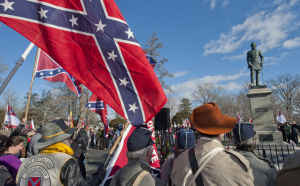Lee-Jackson marchers in Lexington bristle at new restrictions
LEXINGTON — The long post-war continued Saturday as hundreds gathered to pay tribute to the two greatest generals of the Confederate South — and gray-clad marchers grumbled about restrictions on their marking of Virginia’s Lee-Jackson holiday.
Shouffler and his friend Lee Hall of Waynesboro, another member of the honor guard, wore gray uniforms and carried working replicas of the .58-caliber, 1853-vintage Enfield rifles that would have been typical Civil War weapons. They said they’d been coming to the Lee-Jackson commemorations in Lexington for at least a decade to show their appreciation for the sacrifice of the Southerners of the early 1860s, whom they described as battling out of a sense of duty to their states rather than as defenders of slavery.
“The states meant more to people than they do now,” Shouffler said.
“Honor was a word that meant more,” echoed David Meisky of Buena Vista, who wore the wool clothes of a 19th-century country gentleman Saturday but who often dresses in uniform to portray William “Extra Billy” Smith, a Confederate officer and two-time governor of Virginia.Hall said he was at Saturday’s ceremony for a religious reason as well. “Stonewall Jackson is the man who led me to Christ more than anyone else,” he said, explaining that his life was transformed by reading in historian and former Virginia Tech professor James Robertson’s best-selling biography about Jackson’s faith.
The onlookers at the cemetery included the merely curious, motorcyclists in leather “motorized cavalry” jackets and also Kelly Hinson of Jackson Springs, N.C., who strode between the grave markers in a black veil and hoop skirt. It was an exact copy, she said, of the mourning clothes worn by Jackson’s widow, Mary Jackson, and also a costume from Hinson’s one-woman play “Mrs. Stonewall Jackson,” which she performs about 50 times per year.
Saturday’s events were shadowed by the conclusion last year of a two-year court battle over a Lexington ordinance that allows only the Virginia and United States flags — and an as-yet-undesigned city flag — to be flown from the city-owned light poles. In 2010, the Stonewall Brigade Camp 1296 of the Sons of Confederate Veterans, which organizes Lee-Jackson Day events, had received city permission to drape downtown in Confederate flags.
“As soon as we got them up, they moved to restrict it,” Camp Commander Brandon Dorsey recalled Saturday.
Lexington Councilwoman Mary Harvey-Halseth, who has sought to relax the rules on flags and banners, was the sole city official to speak at the wreath-laying.
I’m so pleased you come here every year,” she told the crowd, then delivered a brief history lesson on Lee and Jackson’s careers. After the war, Harvey-Halseth reminded her audience, “Lee knew that prolonging the conflict was in nobody’s best interest.”
The flag dispute attracted national attention. On Saturday, members of the Virginia Flaggers group from Richmond waved Confederate flags from Lexington street corners to show their opposition to the city ban.
Also this year, Virginia Military Institute, where Jackson taught for a decade before the Civil War and whose campus had been part of a route for Lee-Jackson marchers in recent years, said period weapons would not be allowed on university property this year. The march that followed this year’s wreath-laying did not go to VMI’s campus.
Wayne Carlson of Dublin and Jeff Frye of Radford did not wear Civil War-era garb to the wreath-laying, but carried flags — Carlson had the third national flag of the Confederacy, Frye the more familiar “Stars and Bars” battle flag. Former members of the Sons of Confederate Veterans, they said they had been attending Lee-Jackson events in Lexington for 15 years to pay tribute to the generals.Both were critics of the light pole restriction and VMI’s weapon ban. “We think it’s a pretty sad chapter that they can’t bring themselves to honor these men,” Carlson said.
It was hard to count the crowd circling Jackson’s statue as temperatures hovered in the mid-20s Saturday morning. But participants’ estimates of 300 to 400 people seemed reasonable. “We wish there were … 3,000 to 4,000,” Carlson said.
After the wreath-laying, the gray-garbed, flag-waving ranks moved out along Lexington’s Main Street to the sound of a bagpiper playing “Dixie,” heading to Washington & Lee University, where Lee was the school president after the war and where a midday lecture would discuss Lee and Jackson’s relationship.
The marchers passed the Museum of Military Memorabilia and the Robert E. Lee Building, and the rows of United States and Virginia flags on light poles. The few onlookers scattered as soon as the marchers passed.
Dorsey guessed that probably 500 people attended either the wreath-laying or the lecture at W&L’s Lee Chapel.
“We don’t typically have huge crowds of onlookers,” he said afterward. “It’s not necessarily designed to draw large crowds.”
http://m.roanoke.com/news/virginia/article_c8a19bee-80a5-11e3-9068-0019bb30f31a.html?mode=jqm#.UtyK_bJSPwo.facebook

